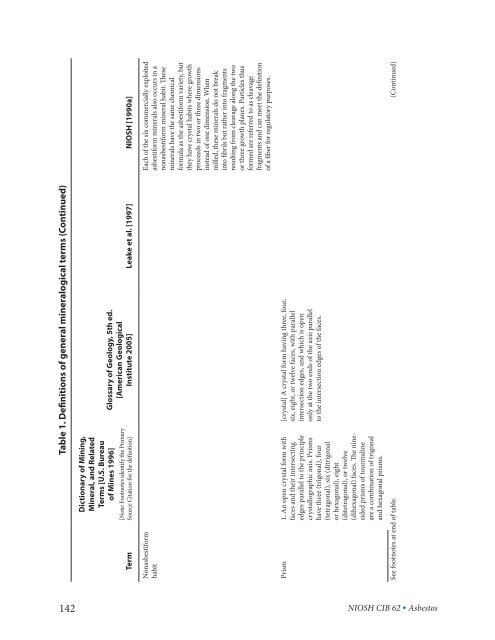Asbestos Fibers and Other Elongate Mineral Particles: State of the ...
Asbestos Fibers and Other Elongate Mineral Particles: State of the ...
Asbestos Fibers and Other Elongate Mineral Particles: State of the ...
- No tags were found...
Create successful ePaper yourself
Turn your PDF publications into a flip-book with our unique Google optimized e-Paper software.
Table 1. Definitions <strong>of</strong> general mineralogical terms (Continued)<br />
142<br />
Glossary <strong>of</strong> Geology, 5th ed.<br />
[American Geological<br />
Institute 2005] Leake et al. [1997] NIOSH [1990a]<br />
Dictionary <strong>of</strong> Mining,<br />
<strong>Mineral</strong>, <strong>and</strong> Related<br />
Terms [U.S. Bureau<br />
<strong>of</strong> Mines 1996]<br />
[Note: Footnotes identify <strong>the</strong> Primary<br />
Source Citation for <strong>the</strong> definition]<br />
Term<br />
Each <strong>of</strong> <strong>the</strong> six commercially exploited<br />
asbestiform minerals also occurs in a<br />
nonasbestiform mineral habit. These<br />
minerals have <strong>the</strong> same chemical<br />
formula as <strong>the</strong> asbestiform variety, but<br />
<strong>the</strong>y have crystal habits where growth<br />
proceeds in two or three dimensions<br />
instead <strong>of</strong> one dimension. When<br />
milled, <strong>the</strong>se minerals do not break<br />
into fibrils but ra<strong>the</strong>r into fragments<br />
resulting from cleavage along <strong>the</strong> two<br />
or three growth planes. <strong>Particles</strong> thus<br />
formed are referred to as cleavage<br />
fragments <strong>and</strong> can meet <strong>the</strong> definition<br />
<strong>of</strong> a fiber for regulatory purposes.<br />
Nonasbestiform<br />
habit<br />
[crystal] A crystal form having three, four,<br />
six, eight, or twelve faces, with parallel<br />
intersection edges, <strong>and</strong> which is open<br />
only at <strong>the</strong> two ends <strong>of</strong> <strong>the</strong> axis parallel<br />
to <strong>the</strong> intersection edges <strong>of</strong> <strong>the</strong> faces.<br />
Prism 1. An open crystal form with<br />
faces <strong>and</strong> <strong>the</strong>ir intersecting<br />
edges parallel to <strong>the</strong> principle<br />
crystallographic axis. Prisms<br />
have three (trigonal), four<br />
(tetragonal), six (ditrigonal<br />
or hexagonal), eight<br />
(ditetragonal), or twelve<br />
(dihexagonal) faces. The ninesided<br />
prisms <strong>of</strong> tourmaline<br />
are a combination <strong>of</strong> trigonal<br />
<strong>and</strong> hexagonal prisms.<br />
See footnotes at end <strong>of</strong> table. (Continued)<br />
NIOSH CIB 62 • <strong>Asbestos</strong>

















